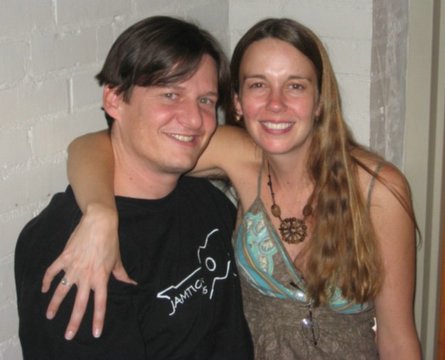
Petén is the region in the north, sandwiched between Mexico and Belize. (Quetzaltenango, where we live, is in the southwest of the country)

In this view, you can see the contrast between the low-lying jungles of Petén and the mountainous highlands that comprise the rest of Guatemala to the south and west.
Petén is Guatemala’s vast, mostly undeveloped jungle frontier, the land of monkeys, parrots, waterfalls, caves, tarantulas, malaria, and film crews for the popular Survivor TV show.
It’s also a land full of ancient Mayan ruins, including the astonishing Tikal and the mega-city of El Mirador. Estimated to have held around 80,000 people during its peak around the time when Christ was alive, El Mirador covers almost 10 square miles, and it is now so deep in the thick jungle that it requires several days of hiking or horseback riding to reach the site. We’re not ashamed to report that we’re not that we’re not that hardcore (yet), so our goal was the easy-to-reach Tikal.
On our way to and from Tikal, we passed through a couple of sweet spots. One of these was Lago Petén Itzá, a large lake in the mostly flat jungle area around Tikal. Here we visited the department capital of Flores (which means "flowers" in English). More of a town than a city, Flores is really an attractive setting, situated on a small island in a pretty corner of the lake, and connected to the mainland by a short causeway.

A view of Flores from afar (thanks to a random travel website in Germany for this image)

The view from Flores across a narrow section of Lake Petén Itzá, to a nearby village

Christmas in Flores features another of the ubiquitous "Gallo Trees". See the Christmas section for more on these trees.
We didn’t stay in Flores, though, because the only place in town with budget rooms (a great Dutch-owned hostel called Los Amigos, where some friends of ours were staying) was full when we arrived.
Instead, we camped in a beautiful and tranquil site called Gringo Perdido, on the north shore of the lake about 20 miles from Flores, just outside the tiny town of El Remate.
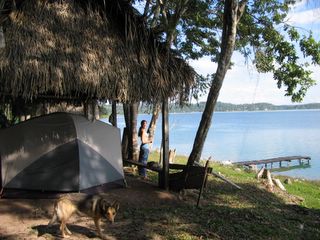
Our beautiful campsite on the shore of Lake Petén Itzá.
The spot was fantastic for swimming in the lake and watching the sunset. Our campsite was mostly empty, except for a nice couple from Germany who have been traveling throughout North and Central America for the past 2 years in their German BMW mobile home that they shipped over on a boat.

Fun and games for the dogs (including 2 local dogs which Kina befriended). On the right you can see the BMW German mobile home, while our tent is on the left.
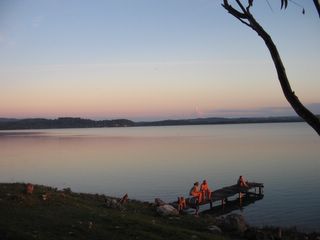
Watching the sunset with the nice German couple

This was a spectacular sunset!
Nearby we found a French restaurant (Mon Amí) and an Italian restaurant (Los Orqídeas), both casual places with open-air seating, owned by French and Italian ex-pats. The Italian restaurant was especially good on Christmas Eve, though a little pricey for Guatemalan standards.
Christmas Eve
At the campsite on the shore of Lake Petén Itzá, we learned about the traditions of Christmas Eve in Guatemala. For one thing, the traditional Christmas Eve dinner is tamale, and this was featured on just about every menu. However, the more...um...noticeable of the Christmas Eve traditions was the THOUSANDS OF FIREWORKS at midnight.
From our campsite on the shore, we could see fireworks coming from at least four distinct towns around the lake. Apparently every town in the country has their own midnight firework show. The fireworks went off in voluminous amounts for about 15 minutes, and then sporadically for another couple of hours. If that wasn’t enough, someone in the town of El Remate (maybe a bar?), about 2 miles away, played unbelievably loud dance music which must have kept all of the residents awake until at least 2am. (Then again, Guatemalans do seem to have a high tolerance for high volume) Anyways, PARTY!
Christmas Day
After waking up Christmas morning in our lake-shore campsite, we drove a few hours south into the low-lying Maya Mountains, through the large town of Poptún, to spend the day with dozens of other travelers at Finca Ixobel. Finca Ixobel is a remote hostel / hotel / campground in the jungle, owned by an ex-pat American named Carole DeVine.

Our room at Finca Ixobel was inside this building, with the hammock outside our back door.
Besides housing a working farm, Finca Ixobel sports a conglomeration of guest houses, campsites, and "tree houses" built around massive pines. The inn offers its global backpacker clientele a variety of activities, including horseback riding, inner-tubing on a nearby river, and guided hikes to several caving expeditions, one of which has a river running through it, providing spectacular underground swimming holes. "Back at the ranch", various other activities abound, including a swimming pond, ping-pong tables and an Internet cafe.

Carley "hard at work" in Finca Ixobel's jungle-bound Internet cafe
However the main attraction at the Finca is the nightly candlelit dinner served buffet-family-style at communal picnic tables. Our Christmas dinner was turkey-style (Carley passed on the turkey as usual, but did go for the mashed potatoes with gravy).
The finca has a very nice ambience, and it’s a great place to meet other travelers and share stories. We met a number of travelers from all over, especially Israel, Germany and Belgium . They also offer volunteer opportunities here; if you want to spend a couple of months working at the finca, your room and board are free, which is a great option for long-term travelers.

On one edge of the property is a swimming pond and a bar, both set far away from the sleeping rooms. This view is from inside the bar, where you can see a Christmas tree on the right and a nearby bonfire circle.
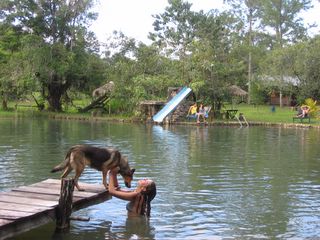
Swimming is a popular activity here, even in December! The bar is in the background on the right.

From the pond is a nice view of a small but extremely steep nearby hill. This hill is actually a popular hiking expedition. It doesn't look like much from here, but...
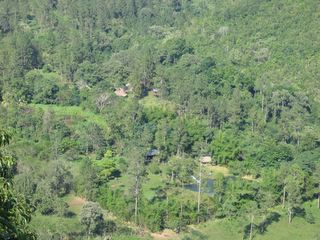
...it's actually a tough little climb, which is likely to cause your clothes to be covered in mud! From the top of the hill, there is a nice view of the swimming pond and the rest of Finca Ixobel.

Jürgen, our German traveling mate for this part of our trip, on top of the hill, with Finca Ixobel far below in the background.
Finca Ixobel also has a garden on the property where they grow many of their own vegetables. They also raise sheep and chickens.

We don't really know what the sheep are for, but we're pretty sure we didn't eat any of them!
The only aspect of Finca Ixobel that conjures a note of sadness is the story of Michael DeVine. Michael was the husband of Carole (the current owner) who was brutally murdered (actually beheaded) by members of the Guatemelan army on June 8, 1990. This was during the period when Guatemala's civil war of more than 30 years was still raging. (It ended in 1996) The reason for this horrible crime has never come to light, but there are rumors that the Guatemalan army officers who killed him were on the CIA payroll. Whatever the case, the murder angered the US government, prompting them to suspend military aid to Guatemala. After a drawn-out investigation which cast little light on their motives, five soldiers were convicted of the murder in September 1992. (Incidentally, that was the first time that Guatemala had ever imprisoned members of the army for murder, despite thousands of documented massacres during the war.) Sadly, other perpetrators managed to evade capture, and their commanding officer, Captain Hugo Contreras, escaped from jail shortly after his arrest. Carole fought the case for years, but fortunately for us and thousands of other travels, she's remained in Guatemala to run the finca.

Carole DeVine, the ex-pat American owner of Finca Ixobel (photo used without permission)
Next - the most famous of the ancient Mayan cities, Tikal
